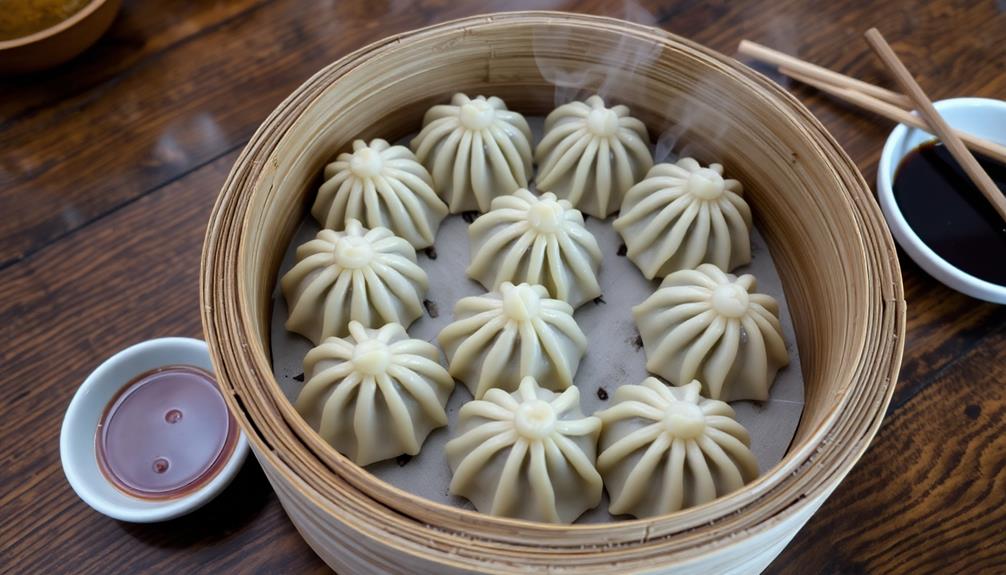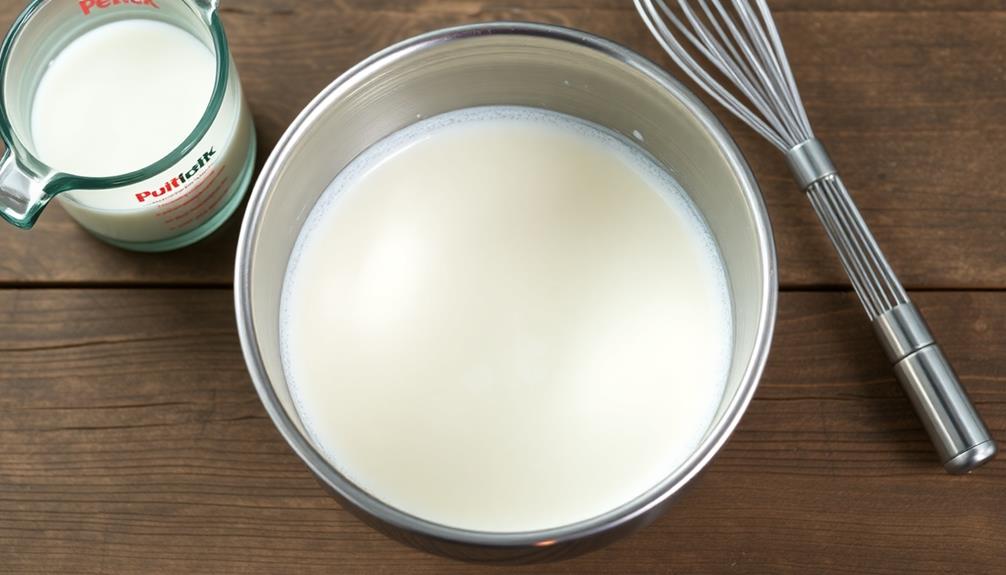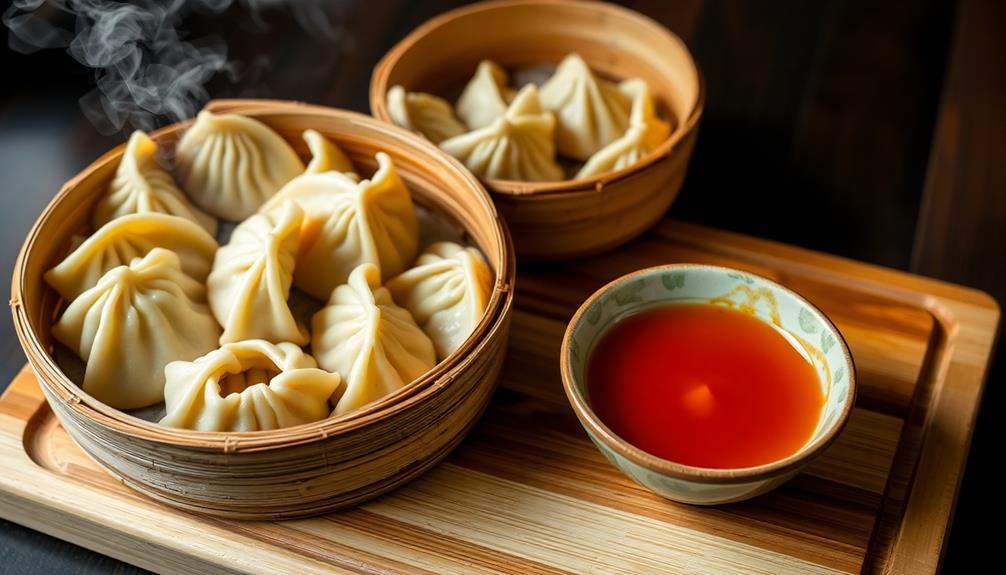Dumplings are a beloved culinary classic with roots tracing back to ancient China. Over centuries, they've adapted to diverse regional tastes, making their way across trade routes to influence cuisines worldwide. Now, you can recreate this time-honored tradition right at home with an easy dumpling recipe. Start by kneading a simple dough and filling it with your choice of savory meats or vibrant veggies. Then, you can boil, steam, or pan-fry your dumplings to perfection. Not only is this process rewarding, but it also encourages creativity and social enjoyment. If you'd like to explore the art of dumpling-making further, continue reading for a step-by-step guide.
Key Takeaways
Key points to answer the search query "Easy Dumplings Recipe at Home":
- This recipe provides a simple and accessible approach to making homemade dumplings, with instructions for kneading the dough, rolling the wrappers, and various cooking methods.
- The dough only requires 2 cups of all-purpose flour, 1/2 teaspoon of salt, and 3/4 cup of warm water, making it a straightforward and uncomplicated process.
- The versatile filling can be made with 1 pound of ground pork or an alternative protein, along with flavor enhancers like garlic, ginger, soy sauce, sesame oil, and scallions.
- The dumplings can be boiled, steamed, or pan-fried, allowing home cooks to experiment with different cooking techniques and explore the unique results each method provides.
- The recipe highlights the satisfying and rewarding experience of crafting homemade dumplings, as well as the social and creative aspects of the process.
History
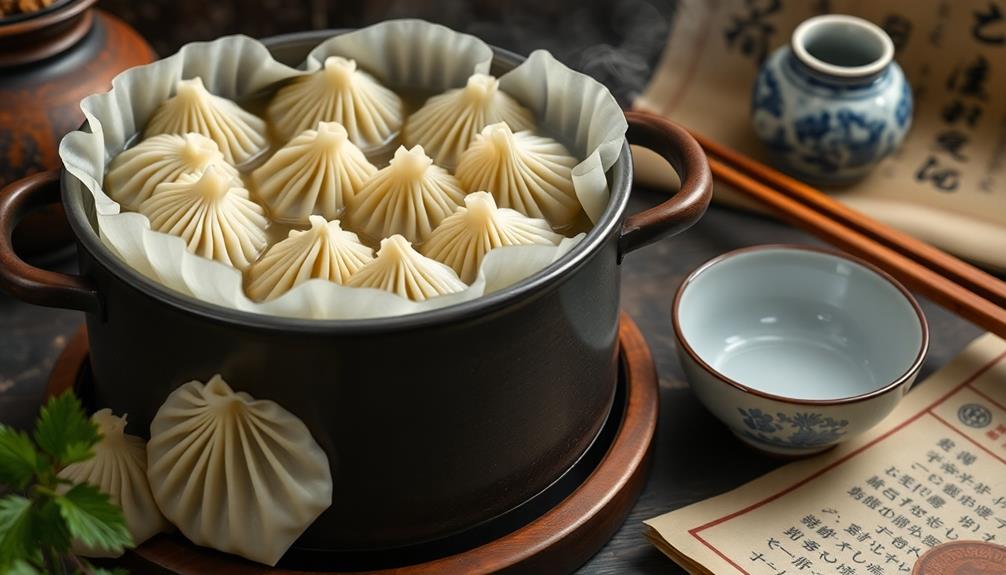
Dumplings' culinary roots trace back to ancient China, where dough-wrapped delicacies graced imperial banquet tables.
These pockets of savory or sweet fillings gained popularity as a versatile meal, evolving over centuries to suit regional tastes and cooking methods.
In the 7th century, the Chinese dish jiaozi emerged, featuring a thin dough wrapper and a range of fillings like meat, vegetables, and herbs.
As trade routes expanded, dumplings crossed cultural boundaries, influencing cuisines from Tibet to Japan.
By the 13th century, the Mongol Empire had introduced dumplings to Eastern Europe, where they were adapted into local specialties like the Russian pelmeni and the Polish pierogi.
Today, dumplings remain a beloved comfort food worldwide, with countless variations reflecting diverse culinary traditions.
From the delicate xiaolongbao of Shanghai to the hearty momos of Nepal, these pockets of flavor continue to delight and nourish palates across the globe.
Recipe
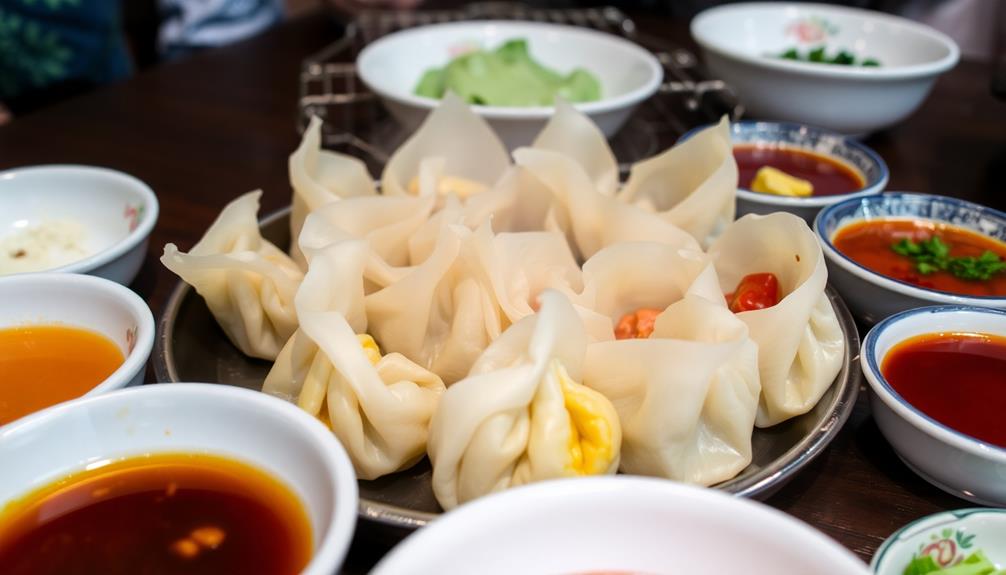
Dumplings are a beloved comfort food enjoyed around the world. These savory pockets of dough filled with delicious ingredients are a true delight to make and eat. Whether you prefer them steamed, boiled, or pan-fried, dumplings offer a satisfying and versatile culinary experience.
In this easy recipe, you'll learn how to create homemade dumplings that are perfectly tender and flavorful. With a few simple ingredients and a little bit of time, you can bring the authentic taste of dumplings right to your own kitchen.
Ingredients:
- 2 cups all-purpose flour
- 1/2 teaspoon salt
- 3/4 cup warm water
- 1 pound ground pork (or your preferred protein)
- 2 cloves garlic, minced
- 1 tablespoon grated ginger
- 2 tablespoons soy sauce
- 1 teaspoon sesame oil
- 1/4 cup finely chopped scallions
To prepare the dumplings, begin by making the dough. In a large mixing bowl, combine the flour and salt. Gradually add the warm water and knead the mixture until a smooth, elastic dough forms. Cover the dough and let it rest for 30 minutes.
In a separate bowl, mix the ground pork, garlic, ginger, soy sauce, sesame oil, and scallions until well combined. This will be the filling for your dumplings.
Take a small portion of the rested dough and roll it into a thin round wrapper. Place a spoonful of the filling in the center of the wrapper, then fold the dough over to create a half-moon shape. Crimp the edges to seal the dumpling.
Repeat this process until all the dough and filling have been used. You can choose to steam, boil, or pan-fry the dumplings, depending on your preference.
When cooking the dumplings, be sure to handle them gently to prevent them from breaking. Serve hot, with your favorite dipping sauce on the side. Enjoy the delightful flavors and textures of these homemade dumplings!
Cooking Steps

First, knead the dough on a lightly floured surface until it's smooth and pliable.
Then, roll the dough into small, bite-sized balls.
Finally, boil the dumplings in simmering water until they float to the top, indicating they're cooked through.
Don't forget to drain the dumplings and garnish them with freshly chopped parsley before serving.
Step 1. Knead Dough on Lightly Floured Surface
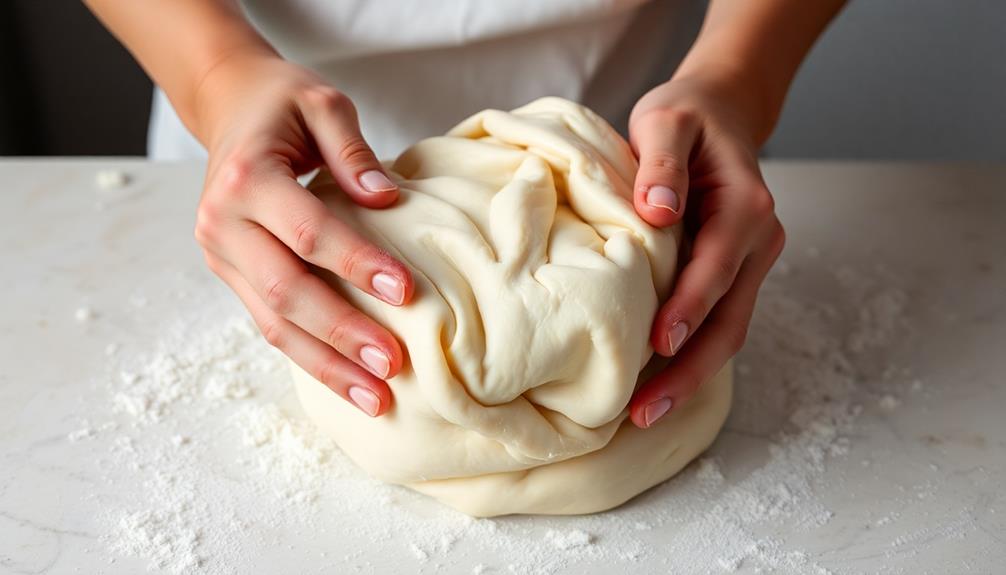
Next, you'll want to lightly flour a clean work surface. This will help prevent the dough from sticking as you knead it.
Gently turn the dough out onto the floured surface and use your hands to shape it into a rough ball. Begin kneading the dough by pressing it down with the heel of your hand, then fold the dough over and push it away from you. Give the dough a quarter turn and repeat this process for about 5 minutes.
You'll know the dough is ready when it becomes smooth and elastic. If the dough seems too sticky, lightly dust the surface with more flour. Conversely, if the dough feels too dry, sprinkle in a small amount of water and continue kneading.
The key is to work the dough until it has a soft, pliable texture that's easy to roll out. Once it's properly kneaded, you can move on to the next step of the recipe.
Step 2. Roll Dough Into Small Balls

After kneading the dough, divide it into equal portions. This will make it easier to roll each piece into a small ball. Lightly flour your work surface to prevent the dough from sticking.
Take one portion of the dough and use your hands to gently roll it into a smooth, round ball.
- Apply gentle pressure and rotate the dough to create a uniform shape.
- The balls should be about 1-inch in diameter for the best dumpling size.
- If the dough seems too sticky, lightly dust your hands with flour before rolling.
Repeat this process with the remaining dough, arranging the dumplings on a lightly floured surface as you go.
Once all the dough has been rolled into balls, your dumplings are ready for the next step. Be mindful not to overwork the dough, as this can make the dumplings tough.
With a little practice, you'll be rolling perfect dumplings in no time.
Step 3. Boil Dumplings in Simmering Water
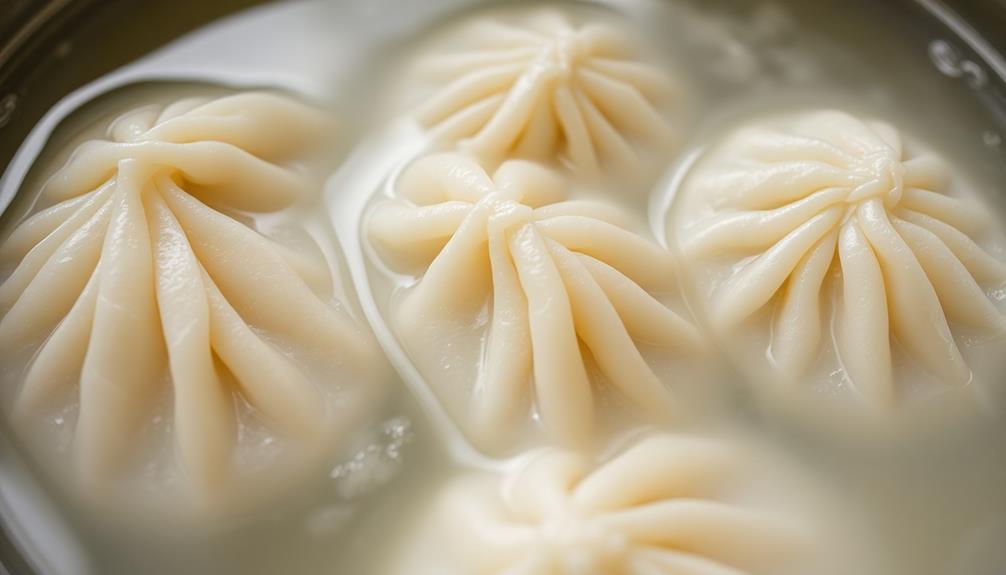
With the dumplings rolled and ready, it's time to start cooking them.
Bring a large pot of water to a gentle simmer over medium heat. Once the water is simmering, carefully drop the dumplings into the pot one by one, making sure they don't stick together.
Gently stir the dumplings to prevent them from sticking to the bottom of the pot. Cook the dumplings for about 10-12 minutes, or until they float to the surface and are cooked through.
To check if the dumplings are done, you can use a toothpick or fork to gently poke one. The filling should be hot and the dough should be tender and cooked all the way through.
Once the dumplings are cooked, use a slotted spoon to carefully transfer them to a serving plate. Serve them hot, with your favorite dipping sauce on the side, such as soy sauce, vinegar, or chili oil.
Enjoy your homemade dumplings!
Step 4. Drain Cooked Dumplings From Water
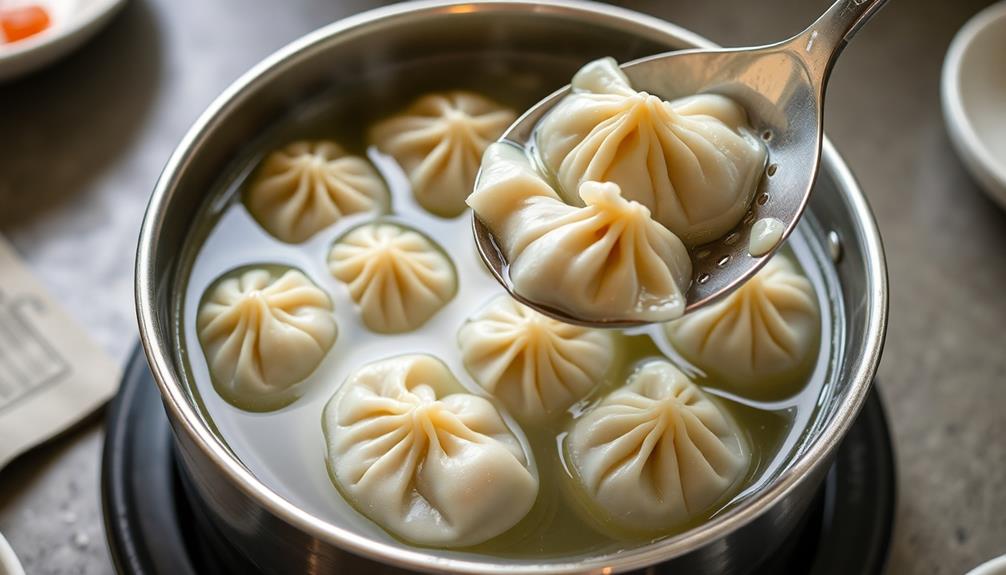
Once the dumplings have finished cooking and floated to the surface, use a slotted spoon to carefully transfer them from the simmering water to a serving plate. This method ensures you don't lose any of the delicate dumplings in the process.
Gently shake the spoon to allow excess water to drip back into the pot before placing the dumplings on the plate. It's important to drain the dumplings thoroughly to prevent them from becoming soggy. If there's too much water left clinging to them, it can dilute the flavors and make the texture less appealing.
Once all the dumplings have been transferred, you can optionally give the plate a slight tilt to let any remaining water drain off.
Now that your freshly cooked dumplings are ready, you can serve them immediately, garnished with your choice of toppings like chopped scallions, toasted sesame seeds, or a dipping sauce on the side.
Enjoy the steaming, pillowy goodness of your homemade dumplings!
Step 5. Garnish With Chopped Parsley
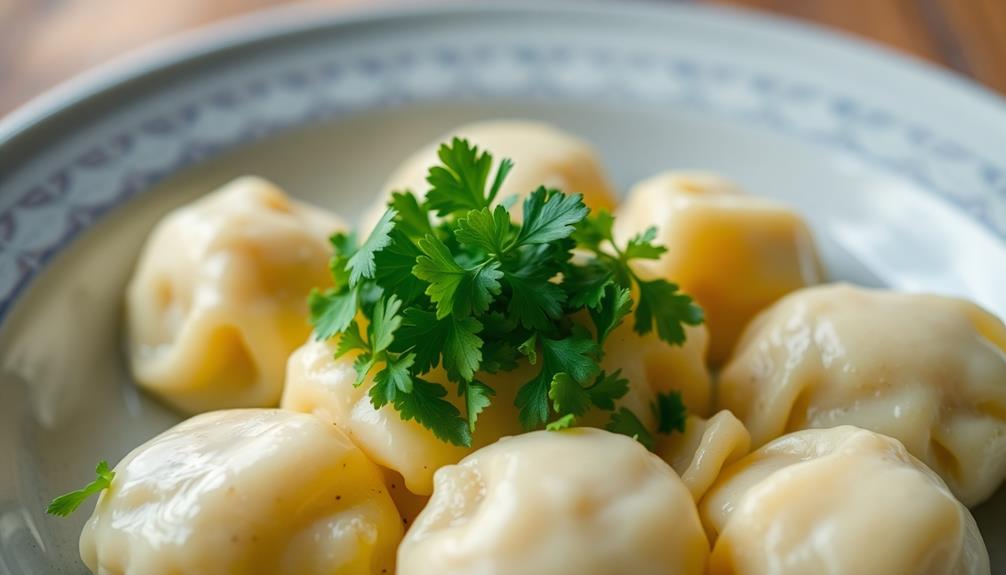
Now that your dumplings are nicely drained, it's time to add the finishing touch with a sprinkle of freshly chopped parsley. This vibrant, aromatic herb not only enhances the visual appeal of your dish but also adds a burst of fresh flavor that perfectly complements the hearty, comforting dumplings.
To garnish your dumplings, simply take a handful of fresh parsley leaves and give them a quick, fine chop. You can use a sharp knife or a pair of kitchen scissors for this task. The key is to chop the parsley finely, ensuring that the pieces are small and evenly distributed across the top of your dumplings.
Once your parsley is chopped, sprinkle it generously over the drained dumplings. The bright green flecks of parsley will create a beautiful contrast against the soft, pillowy texture of the dumplings, making your dish look and taste even more irresistible.
Enjoy your perfectly garnished dumplings and savor the delightful combination of flavors and textures.
Final Thoughts
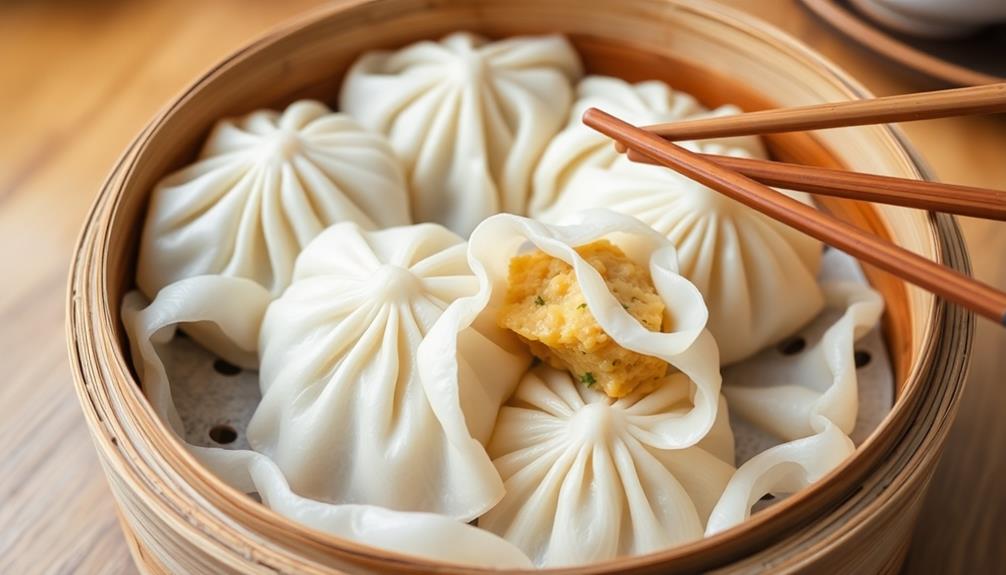
Making these homemade dumplings is a simple and rewarding experience. With the right techniques, you can elevate your cooking skills and impress family and friends. While the process may seem daunting at first, the end result is well worth the effort. You don’t need to be a professional chef to master the art of dumpling-making. By following an **easy homemade dumplings recipe**, even beginners can create delicious, authentic flavors with minimal ingredients. Soon enough, you’ll have a batch of perfectly folded dumplings ready to enjoy, whether steamed, boiled, or fried.
The final thoughts on this easy dumplings recipe are that it's a versatile dish that can be customized to suit your taste preferences. Consider experimenting with different fillings, such as savory meats or vibrant vegetables.
Additionally, you can play with various cooking methods, like boiling, steaming, or pan-frying, to achieve your desired texture and flavor.
Most importantly, enjoy the process of making these dumplings from scratch. Take pride in your homemade creations and savor each delicious bite. Don’t worry about achieving perfection—it’s the love and effort you put into each fold that truly matters. Follow the homemade dumpling recipe instructions carefully, but feel free to add your own personal touch to make them uniquely yours. Sharing these dumplings with friends and family will make the experience even more special.
The satisfaction of crafting a meal with your own two hands is unparalleled. So, why not give this recipe a try and see for yourself how rewarding it can be?
Frequently Asked Questions
Can I Use Fresh or Frozen Dumplings for This Recipe?
You can use either fresh or frozen dumplings for this recipe. Both will work well, so choose whichever option is more convenient for you. The cooking process should be similar regardless of whether you use fresh or frozen dumplings.
How Long Can Homemade Dumplings Be Stored?
Homemade dumplings can be stored for up to 3 days in the refrigerator or up to 3 months in the freezer. Make sure to store them in an airtight container to preserve their freshness and texture.
What Is the Best Way to Reheat Cooked Dumplings?
To reheat cooked dumplings, you can steam them for 5-7 minutes, or simmer them in broth for 2-3 minutes. Microwaving isn't recommended as it can make the dumplings tough and chewy. The best way is to steam or simmer them gently to preserve their texture.
Can I Make the Dough in Advance?
Yes, you can make the dumpling dough in advance. Simply store it in an airtight container in the refrigerator for up to 3 days. When ready to use, allow the dough to come to room temperature before rolling and shaping the dumplings.
Are There Any Gluten-Free or Vegan Dumpling Options?
Absolutely! There are several gluten-free and vegan dumpling options you can explore. You can use rice flour, cassava flour, or even plant-based wrappers to create delicious, allergen-friendly dumplings that cater to your dietary needs.
